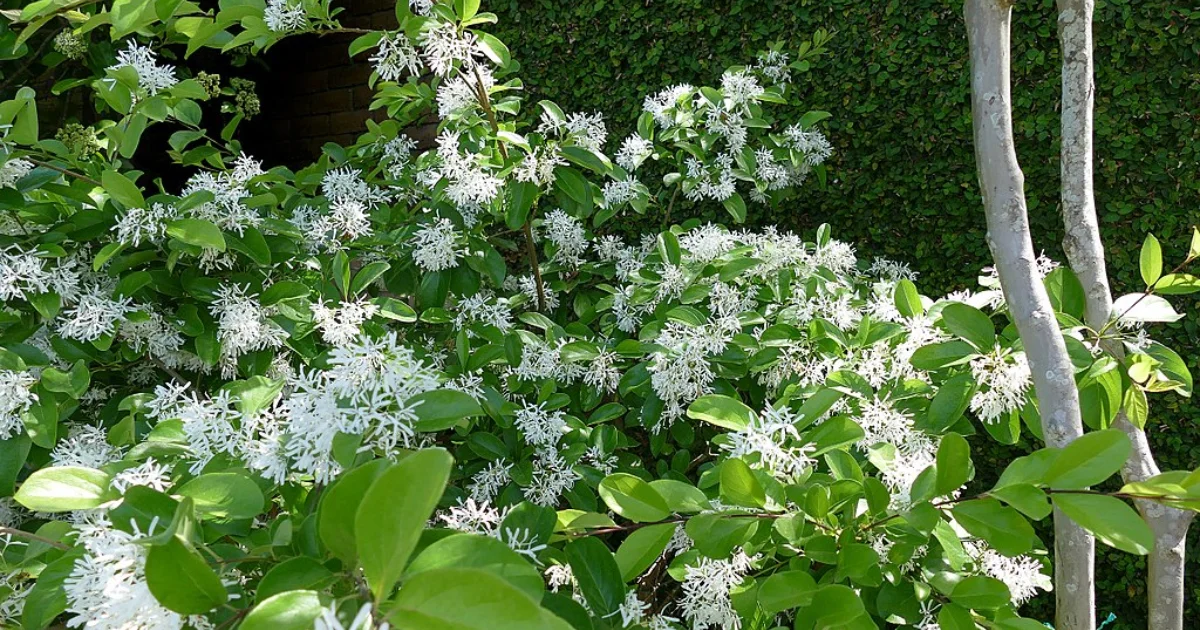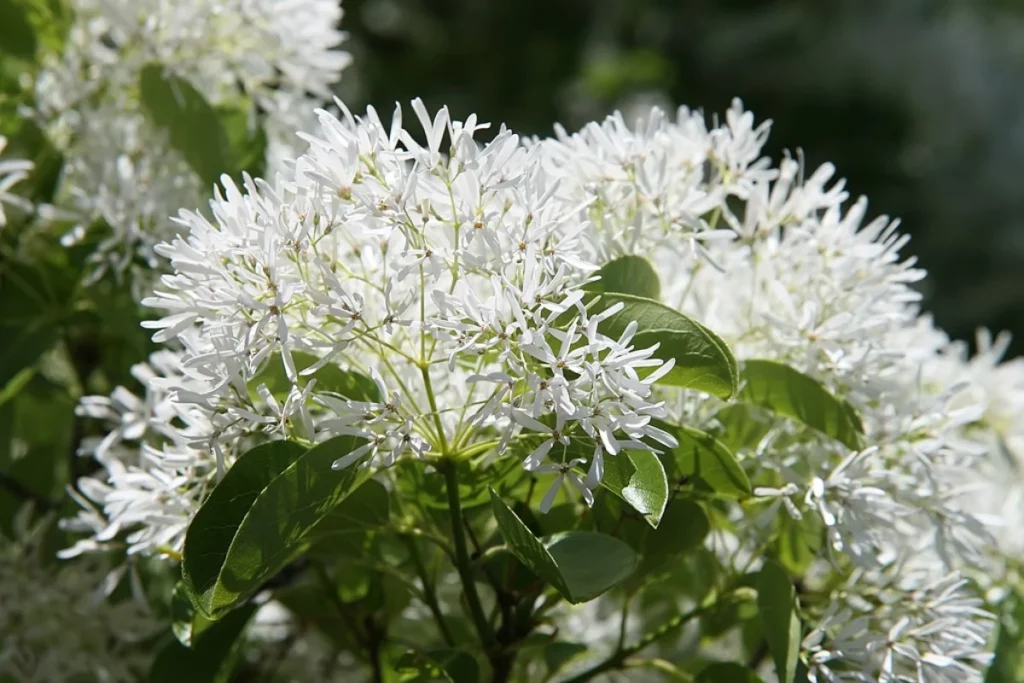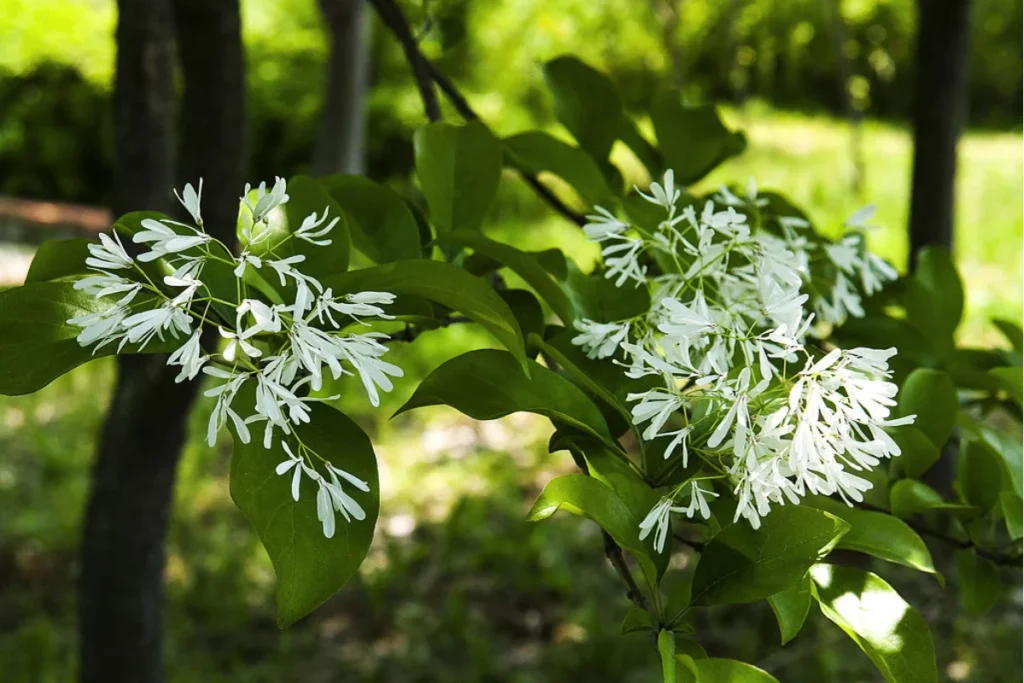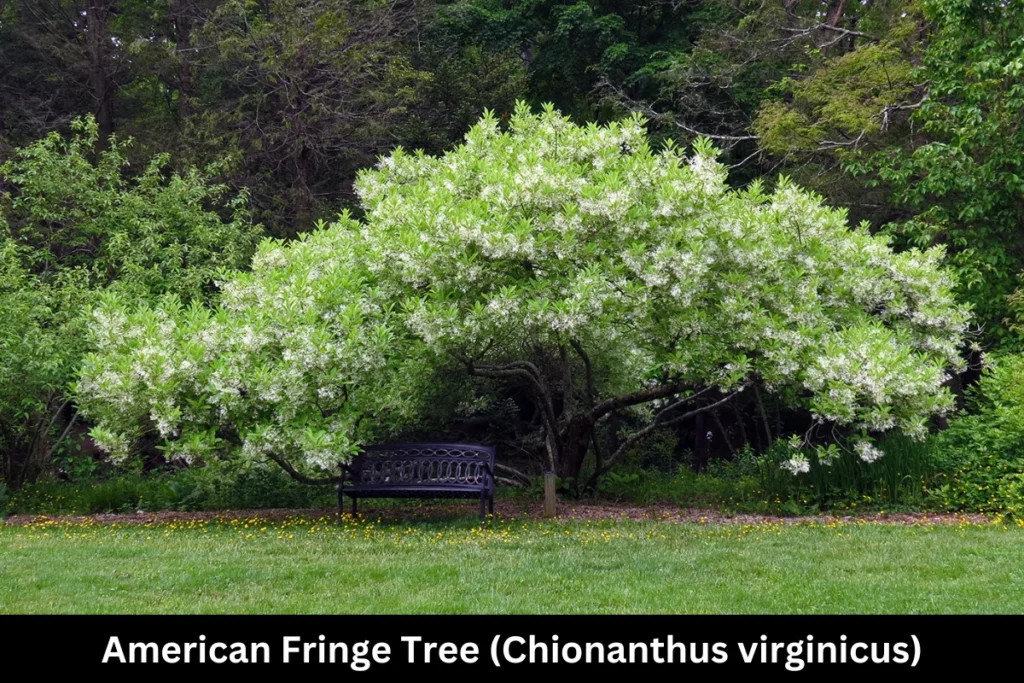How to Grow Chinese Fringe Tree: Exploring Pros and Cons, Growth Rate, Size, and Fruit

Are you searching for a standout specimen to enhance your outdoor sanctuary? Look no further than the Chinese Fringe Tree – a botanical gem that promises to dazzle and delight with its striking beauty and ornamental appeal.
Picture this: elegant branches adorned with clusters of fragrant, fringe-like blooms, set against a backdrop of vibrant green foliage. Intrigued? You should be!
In this comprehensive article, I will uncover the secrets of the Chinese Fringe Tree, exploring everything from its propagation and growth habits to its care requirements and beyond.
Whether you’re a seasoned gardener seeking a new challenge or a beginner looking to make a statement, prepare to be inspired as we dive into the fascinating world of this extraordinary tree.
Chinese Fringe Tree: Summary
- Botanical Name: Chionanthus retusus
- History: In China, the young leaves of this tree have been historically used as a substitute for tea, prized for their fragrance, adding cultural significance to the plant.
- Description: This tree typically grows to a small size with upright branches forming a dome shape. Soft green leaves provide a backdrop for magnificent clusters of fragrant, fringe-like blooms, making it an attractive addition to any garden landscape.
- Recommended Soil pH: Aim for soil with a low pH (under 7.0) – This indicates the optimal acidity level for the soil. Organically rich, well-draining, and moist soil conditions are advised for the Chinese Fringe Tree to thrive.
- Light: The Chinese Fringe Tree prefers full sun to partial sun exposure, indicating the amount of sunlight it needs for optimal growth and flowering.
- Watering: Watering should be done when the top 2 inches of soil is dry, ensuring proper hydration for the tree without waterlogging the roots.
- Blooms: The Chinese Fringe Tree blooms in the spring, producing beautiful clusters of white flowers that add visual appeal and fragrance to the garden.
- Flower Color: The flowers of the tree are white, contributing to its ornamental value and aesthetic charm.
- Foliage Color: The foliage of this tree is typically green, providing a lush backdrop for its delicate blooms.
- Mature Size: Slow-growing, the Chinese Fringe Tree reaches a mature height of 15-20 ft. and a width of 20-25 ft., making it suitable for smaller yards or gardens.
- Special Features: Known for its easy care, the Chinese Fringe Tree also offers additional benefits such as fall color, ornamental berries, and providing food for birds, enhancing its appeal to gardeners.
- Zone: The Chinese Fringe Tree thrives in USDA hardiness zones 5-9, indicating the regions where it can be successfully grown outdoors.
- Care: Regular watering during the first growing season is essential to establish a deep, extensive root system. Once established, watering can be reduced, but prolonged drought should be avoided. Feeding with a general-purpose fertilizer before new growth begins in spring ensures healthy development.
Also Read: Garden Tools and Their Uses
What Does a Chinese Fringe Tree Look Like?
Sharing my personal experience: The moment I laid eyes on the Chinese fringe tree, it was like stumbling upon a hidden treasure in a forest glade. Its branches were adorned with glossy, dark green leaves, whispering secrets of ancient wisdom.
But what truly stole my breath away were the delicate, cascading clusters of fragrant white flowers, each petal dancing in the breeze like tiny fairies. The air was filled with their sweet perfume, and for a moment, time stood still.
As I gazed upon this natural masterpiece, I felt a sense of wonder and awe wash over me, reminding me of the magic that exists in the world around us.

In the image of the Chinese fringe tree above, you can observe its remarkable transformation each spring, as it erupts into a breathtaking spectacle of clustered blooms that drape its branches like delicate fringes.
While marveling at this display, one uncovers an intriguing secret: the male tree showcases more flamboyant flowers, while the female counterpart produces alluring fruits, serving as a delectable feast for birds and certain mammals.
It’s a symphony of nature’s design, where every detail whispers tales of growth and abundance. From its elegant blooms to its fruitful bounty, this tree embodies the harmony and wonder of the natural world, inviting you to explore its captivating story.
Must Read: What Fruits Grow in 30 Days
Understanding the Pros and Cons of the Chinese Fringe Tree
The Chinese Fringe Tree is admired for several reasons but also comes with a few considerations that might be viewed as drawbacks depending on your gardening situation. Here’s an overview of the pros and cons to help you decide if it’s the right tree for your garden:
Pros of Planting a Chinese Fringe Tree:
- Attractive Features: One of the most striking features of the Chinese Fringe Tree is its beautiful, fleecy white blooms that appear in late spring to early summer. These flowers are not only eye-catching but also emit a pleasant fragrance reminiscent of jasmine and vanilla, adding a sensory appeal to your garden.
- Year-Round Interest: This tree offers visual interest throughout all seasons. In autumn, its leaves turn a vibrant yellow, and during winter, the peeling gray bark provides an interesting texture to the landscape.
- Wildlife Friendly: If you’re looking to attract birds to your garden, this tree is an excellent choice. The berries that appear after the blooming season serve as a food source for wildlife, enhancing the biodiversity of your garden.
- Adaptability: The Chinese Fringe Tree is known for its adaptability to a variety of urban conditions, including pollution. It can thrive in both dry conditions and occasional standing water, making it suitable for a range of urban environments.
- Low Maintenance: Once established, this tree is relatively low maintenance. It doesn’t require much pruning and is largely pest-free, which means less work for you in the garden.
Cons of Planting a Chinese Fringe Tree:
- Growth Rate: If you are looking for a fast-growing tree, the Chinese Fringe Tree might not be the best option. This tree is known for its slow growth rate, typically gaining about 4 to 10 inches per year, though it can occasionally grow up to 12 inches per year under optimal conditions with rich, moist soil and adequate fertilization. To optimize the growth of your Chinese Fringe Tree, ensure it is planted in a location that receives full sun to partial shade.
- Size Considerations: While its moderate size (typically 10 to 20 feet tall) makes it a good fit for smaller gardens, it also means it won’t provide the same level of shade as larger trees. This might be a disadvantage if you’re looking to significantly increase the shaded areas in your garden.
- Flowering Consistency: It’s worth noting that the Chinese Fringe Tree may not flower as consistently every year; it tends to have better bloom years alternating with less spectacular years.
- Deer Attraction: If deer are a common sight in your area, this might be a con. The Chinese Fringe Tree is known to suffer from deer damage, which could impact its health and aesthetic appeal.
Overall, the Chinese Fringe Tree can be a wonderful addition to your garden, especially if you value ornamental beauty and wildlife support over rapid growth. Its resilience and low maintenance needs make it a practical choice for urban gardeners looking for a durable, yet beautiful tree.
Chinese Fringe Tree Problems
The main diseases that might affect this tree include:
- Leaf Spot: This is typically caused by fungal infections where spots appear on the leaves.
- Canker: This disease can cause sections of the bark and underlying wood to die off.
- Powdery Mildew: This appears as a white powdery deposit over the leaf surface and can affect the overall health of the tree.
Additionally, in some areas, deer might find the tree’s foliage appealing, which can lead to significant damage if not managed properly.
Must Read: China Doll Plant – Care Tips, Propagation, Benefits, Problems
How to Grow and Care for a Chinese Fringe Tree

1) Propagating Chinese Fringe Trees:
Propagating a Chinese Fringe Tree can be a gratifying endeavor for any gardening enthusiast, and you can do this through several methods, most commonly by seeds or cuttings. Here’s a simple guide that will help you begin:
– Propagation by Seeds
- Seed Collection and Preparation: In autumn, gather seeds from a healthy, disease-free Chinese Fringe Tree when they are ripe and have a blue-purple hue. It’s crucial to select well-formed, uniform seeds for the best results.
- Seed Treatment: Before planting, soak the seeds in water for two days to hydrate them, then let them dry in a cool, ventilated place. To enhance germination, store the seeds in wet sand at a ratio of 3 parts sand to 1 part seeds, and keep them moist but not overly wet to prevent decay.
- Sowing: In the mid-spring of the following year, sow the seeds in a well-prepared nursery bed that has rich, well-drained soil. Utilize a high ridge sowing method with adequate spacing for the seeds to have room to develop. Cover the seeds with a fine layer of soil, making sure to sustain a consistent amount of moisture throughout.
– Propagation by Cuttings
- Cutting Selection: During the summer, select semi-lignified (partially woody) branches from the current year’s growth. Cut these branches into sections, each around 6-8 inches long.
- Preparation for Planting: Treat the cut ends with a rooting hormone to encourage root development. Plant these cuttings in a mix of loamy soil and use a fungicide-treated soil to prevent disease.
- Care for Cuttings: Keep the soil moist and cover the cuttings with a plastic sheet to create a greenhouse-like environment, which helps in retaining humidity. Regularly water and fertilize the cuttings to ensure healthy growth.
Both methods require patience and care, but with the right conditions, you should see your efforts come to fruition as the plants begin to grow. The key is to maintain consistent moisture and protect the young plants from extreme temperatures until they are well established.
2) Selecting Location and Preparing Soil:
- Light Requirements: The Chinese Fringe Tree flourishes under full sun to partial shade. It should be planted where it can receive at least four to six hours of direct sunlight daily for optimal growth.
- Soil Requirements: This tree prefers a well-draining, fertile soil rich in organic matter. It adapts well across a range of soil types from clay to loam and sandy soils, thriving in slightly acidic to slightly alkaline pH conditions.
- Planting Location: Select a spot that offers adequate room for its mature spread to avoid overcrowding and to display its graceful form fully.
3) Planting Technique:
- Best Planting Time: Early spring or during the fall, when the tree is dormant, is ideal for planting. This timing helps the roots establish without the stress of heat.
- How to Plant: Dig a planting hole that is twice the width of the root ball and equally deep to encourage root growth. Position the tree in the center, backfill with soil, and water thoroughly to settle the soil around the roots.
4) Watering and Nutrition:
- Watering Schedule: Water deeply and regularly during the first growing season to establish an extensive root system; thereafter, moderate drought tolerance can be expected. Supplemental water may be needed during extended dry spells.
- Fertilization: Apply a balanced, slow-release fertilizer early in the spring to promote vigorous growth and abundant flowering.
5) Pruning and Maintenance:
- Pruning Guidelines: Minimal pruning is required. Prune for shape and size if necessary after the flowering period to maintain its aesthetic form and prevent overcrowding of branches.
- General Care: Inspect regularly for signs of pests such as borers and treat promptly to prevent damage. Implementing good cultural practices will generally keep the tree healthy and free from fungal diseases like powdery mildew.
6) Cold Hardiness and Deciduous Nature:
- Cold Tolerance: The Chinese Fringe Tree is hardy in USDA zones 5 to 9, enduring winter temperatures down to -20°C (-4°F), which makes it a resilient choice for many climates.
- Leaf Drop: It is a deciduous tree, shedding its leaves in winter after turning a vivid yellow-gold in the fall, which adds a seasonal charm to its surroundings.
7) Landscape Uses:
- Aesthetic Appeal: With its cloud-like blooms in late spring and attractive leaf coloration in fall, it serves as a stunning focal point in residential lawns, botanical gardens, and parks. Its non-invasive nature makes it a responsible choice for integrating into diverse landscapes.
Cultivating a Chinese Fringe Tree in your garden not only enhances the aesthetic value but also supports local biodiversity by attracting birds and pollinators with its fruits and flowers. Its manageable size and elegant appearance make it ideal for urban and suburban settings seeking a touch of natural beauty.
Also Read: Vines with Purple Flowers
American Fringe Tree vs Chinese Fringe Tree

When comparing the American Fringe Tree (Chionanthus virginicus) with the Chinese Fringe Tree (Chionanthus retusus), there are a few distinctive features and differences to consider which can help you decide which might be the better fit for your garden:
Growth and Appearance
- Height and Structure: The American Fringe Tree generally reaches about 12 to 20 feet in both height and spread. It’s often described as having a large shrub-like appearance with a rounded habit, and can be trained into a single trunk. On the other hand, the Chinese Fringe Tree tends to grow a bit taller, usually between 15 to 25 feet, and has a more upright and compact form, which can give it a neater appearance in the landscape.
- Flowers and Blooming: Both trees are known for their stunning, fragrant, white flowers that appear in spring. However, the American variety typically blooms earlier in the spring (April or May), while the Chinese variety blooms a little later (May or June). The flower clusters on the American Fringe Tree are usually looser and more graceful, whereas those on the Chinese Fringe Tree are more compact and held upright on the branches, giving it a tidier look.
- Foliage and Bark: Post-blooming, the leaves of the American Fringe Tree turn a fine, clear yellow in the fall, whereas the Chinese Fringe Tree’s leaves turn yellow and then drop off later in the season. The bark of the Chinese Fringe Tree is also distinctively corky with furrows of dark brown and light gray, which can add winter interest to your garden.
Must Read: Low-Maintenance Indoor Plants for Living Room
Adaptability and Maintenance
- Climate and Hardiness: The American Fringe Tree is native to the eastern U.S. and is adaptable from Canada to the Gulf Coast, making it robust across a variety of climates. The Chinese Fringe Tree, while not native to North America, also shows good adaptability and can flourish in many temperate regions.
- Soil and Water Needs: Both trees do well in moist, well-drained soil, but the Chinese Fringe Tree might be slightly more adaptable to different soil types and urban conditions. They both prefer full sun to partial shade to thrive and showcase their beautiful blooms.
Usage in Landscaping
- Aesthetic Preferences: If you prefer a tree with a weeping form and graceful appearance, the American Fringe Tree might be your choice. It’s ideal for naturalistic settings. However, if you’re looking for a tree that maintains a neater, more controlled appearance throughout the year, the Chinese Fringe Tree could be a better fit.
Both trees offer unique qualities that can enhance your garden, making them excellent choices depending on your specific landscaping needs and aesthetic preferences. Whether you value the loose and graceful form of the American Fringe Tree or the tidy and orderly structure of the Chinese Fringe Tree, both are sure to provide spectacular floral displays and add a touch of elegance to any space.
Must Read: Plants That Like Full Sun and Heat
Conclusion
Patience is key when growing a Chinese Fringe Tree. It grows slowly but can live for many decades, providing beautiful blooms and a pleasant fragrance every spring. Ensure you provide it with the right conditions, and it will become a stunning addition to your landscape. For more detailed growing instructions, you might find these resources helpful.
We’d love to hear from you! If you have any feedback, questions, or would like to share your experiences and stories about growing a Chinese Fringe Tree, please feel free to add your comments below.
Citations:
1. IFAS Environmental Horticulture - Chinese Fringetree
2. Wikipedia - Chionanthus retusus
